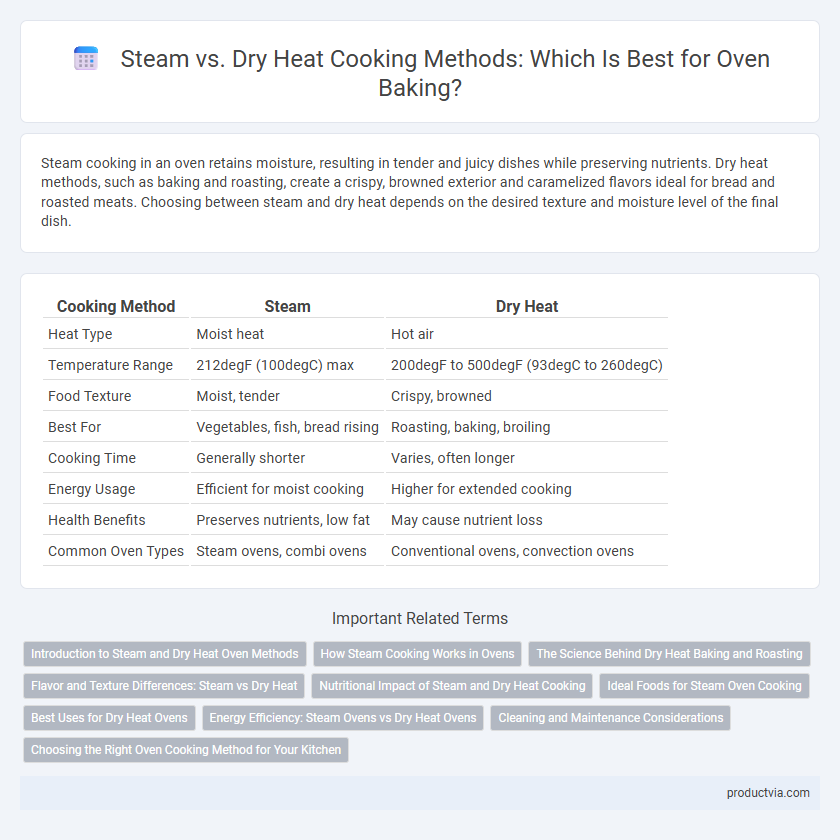Steam cooking in an oven retains moisture, resulting in tender and juicy dishes while preserving nutrients. Dry heat methods, such as baking and roasting, create a crispy, browned exterior and caramelized flavors ideal for bread and roasted meats. Choosing between steam and dry heat depends on the desired texture and moisture level of the final dish.
Table of Comparison
| Cooking Method | Steam | Dry Heat |
|---|---|---|
| Heat Type | Moist heat | Hot air |
| Temperature Range | 212degF (100degC) max | 200degF to 500degF (93degC to 260degC) |
| Food Texture | Moist, tender | Crispy, browned |
| Best For | Vegetables, fish, bread rising | Roasting, baking, broiling |
| Cooking Time | Generally shorter | Varies, often longer |
| Energy Usage | Efficient for moist cooking | Higher for extended cooking |
| Health Benefits | Preserves nutrients, low fat | May cause nutrient loss |
| Common Oven Types | Steam ovens, combi ovens | Conventional ovens, convection ovens |
Introduction to Steam and Dry Heat Oven Methods
Steam cooking ovens generate moist heat by injecting steam into the cooking chamber, which helps retain food moisture and nutrients while promoting even cooking. Dry heat ovens use hot air circulation without added moisture, ideal for roasting, baking, and achieving crisp, browned surfaces. Selecting between steam and dry heat methods depends on the desired texture and flavor of the food, with steam ovens excelling in gentler cooking and dry heat ovens delivering traditional browning and caramelization.
How Steam Cooking Works in Ovens
Steam cooking in ovens uses water vapor to transfer heat, ensuring even temperature distribution and preserving food moisture. This method helps retain nutrients and enhances texture, especially for bread and vegetables. Steam ovens maintain a controlled humidity level, preventing food from drying out and improving overall cooking efficiency.
The Science Behind Dry Heat Baking and Roasting
Dry heat baking and roasting in ovens utilize convection and radiant heat to cook food by gradually raising the temperature, promoting Maillard reactions that create a browned, flavorful crust. The absence of steam allows for moisture evaporation, resulting in crisp textures and concentrated flavors essential for baked goods and roasted meats. Controlling dry heat intensity influences caramelization and texture development, defining the science behind baking and roasting methods.
Flavor and Texture Differences: Steam vs Dry Heat
Steam cooking in an oven retains moisture, resulting in tender, juicy textures and enhanced natural flavors, especially in meats and vegetables. Dry heat methods, such as roasting or baking, promote caramelization and Maillard browning, creating crisp, flavorful crusts with concentrated taste. Choosing between steam and dry heat depends on the desired texture: steam preserves softness and prevents drying, while dry heat develops a rich, crispy exterior.
Nutritional Impact of Steam and Dry Heat Cooking
Steam cooking preserves more water-soluble vitamins such as vitamin C and B-complex compared to dry heat methods, which can cause nutrient degradation through higher temperatures and oxidation. Dry heat cooking, like baking or roasting, enhances flavor via caramelization and Maillard reactions but may lead to greater loss of heat-sensitive nutrients. Choosing steam cooking helps retain the nutritional quality of vegetables and delicate proteins, promoting higher antioxidant retention and enhanced digestibility.
Ideal Foods for Steam Oven Cooking
Steam oven cooking is ideal for vegetables, seafood, and poultry, as the moist heat preserves nutrients, texture, and flavor. Foods like asparagus, salmon, and chicken breasts benefit from steam's ability to prevent drying while ensuring even cooking. This method also suits reheating and baking bread, where moisture retention creates a crispy crust and soft interior.
Best Uses for Dry Heat Ovens
Dry heat ovens excel in roasting, baking, and broiling, where high temperatures evenly cook food and create crispy, caramelized surfaces. Ideal for meats, bread, and pastries, dry heat promotes Maillard reactions that enhance flavor and texture. This method is preferred for dishes requiring a firm, browned exterior without added moisture.
Energy Efficiency: Steam Ovens vs Dry Heat Ovens
Steam ovens use moisture to cook food more quickly at lower temperatures, resulting in energy savings compared to dry heat ovens that rely on higher temperatures and longer cooking times. The condensed steam allows for efficient heat transfer, reducing overall energy consumption by up to 30%. Dry heat ovens typically require preheating and maintain higher heat levels, which increases electricity or gas use during cooking cycles.
Cleaning and Maintenance Considerations
Steam ovens require regular descaling to prevent mineral buildup, ensuring optimal performance and longevity. Dry heat ovens demand thorough cleaning of food residues and grease to avoid smoke and odors during cooking. Proper maintenance of both types enhances oven efficiency and preserves cooking quality.
Choosing the Right Oven Cooking Method for Your Kitchen
Steam cooking in ovens preserves moisture and nutrients, ideal for vegetables, seafood, and bread, enhancing flavor and texture. Dry heat methods like baking and roasting create crisp exteriors and caramelization, perfect for meats and pastries. Selecting an oven with dual steam and dry heat options maximizes versatility, catering to diverse culinary needs and improving overall cooking outcomes.
Steam vs Dry Heat for Oven Cooking Method Infographic

 productvia.com
productvia.com